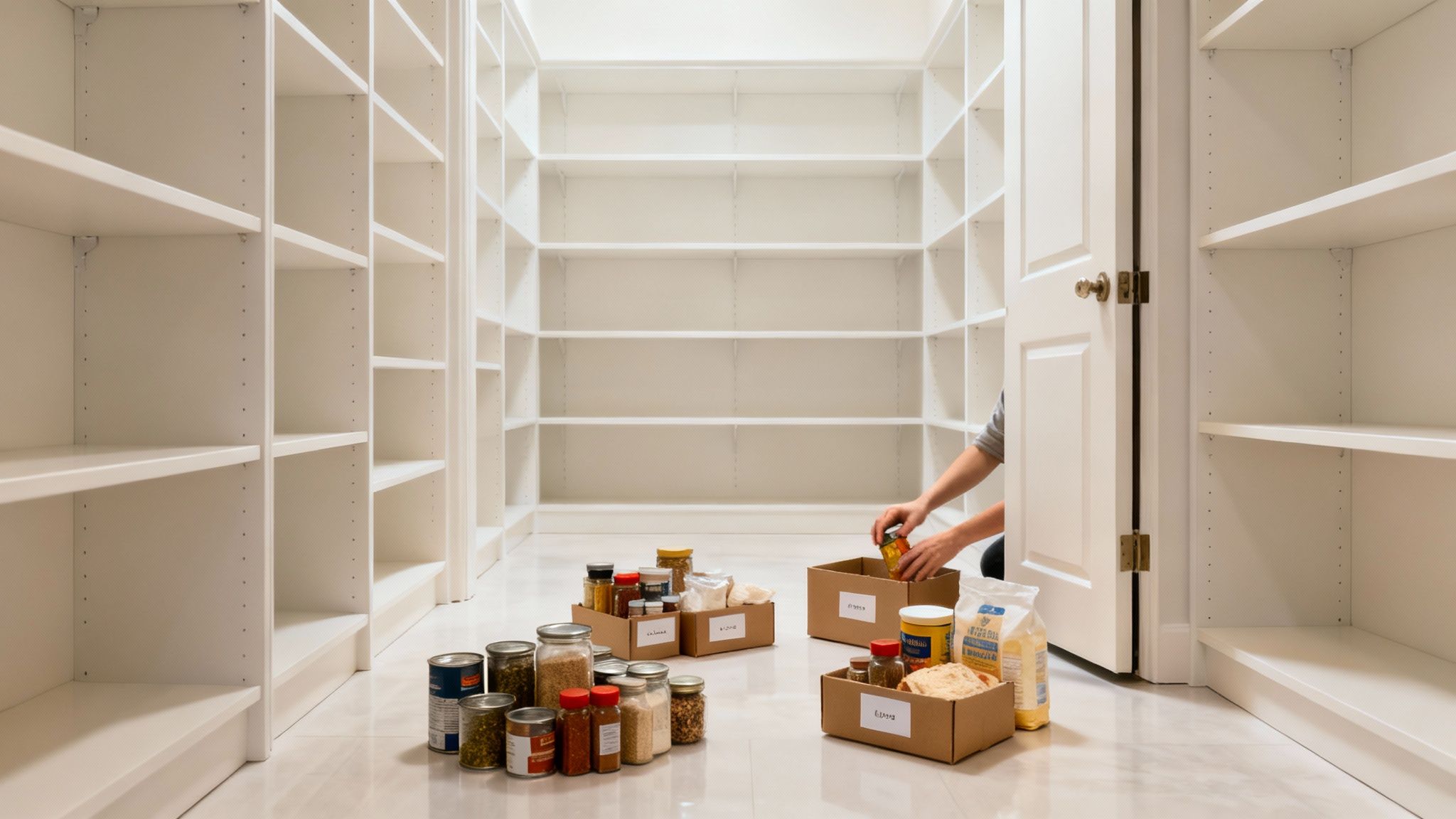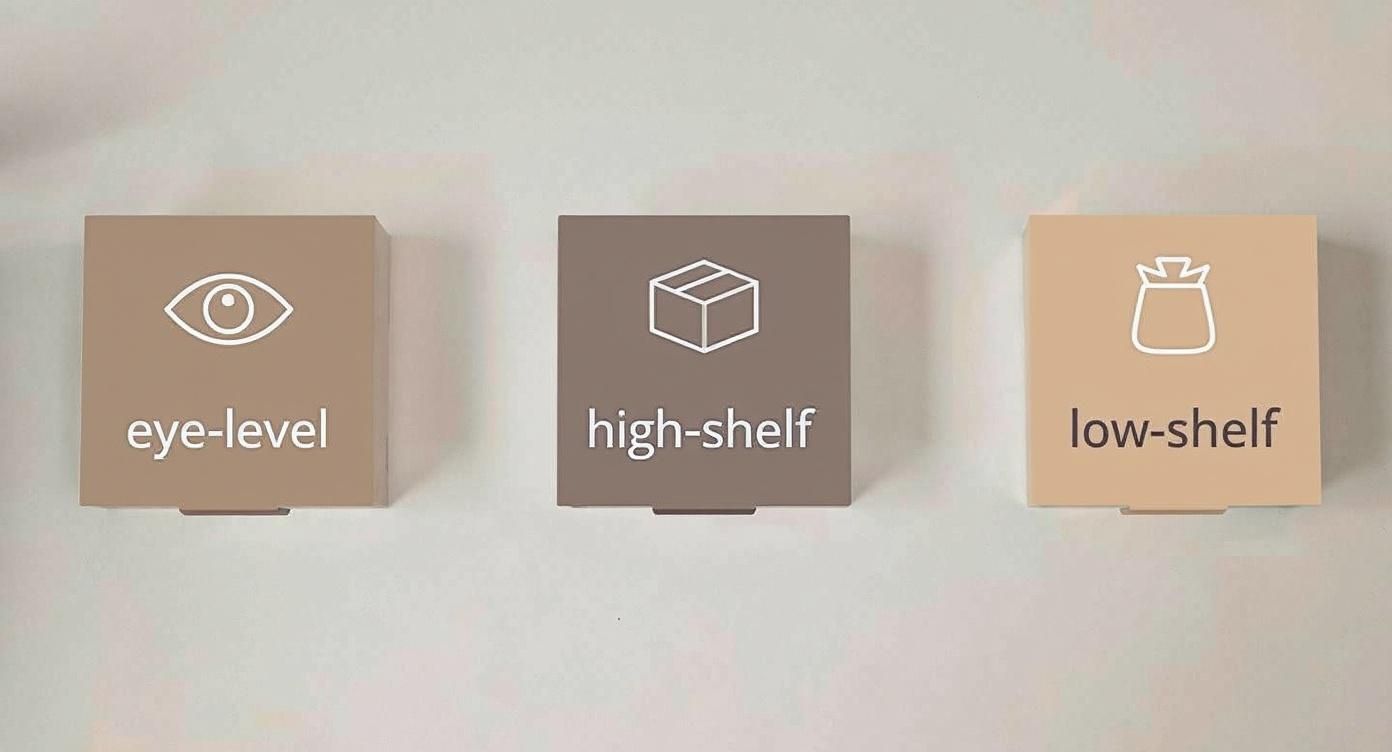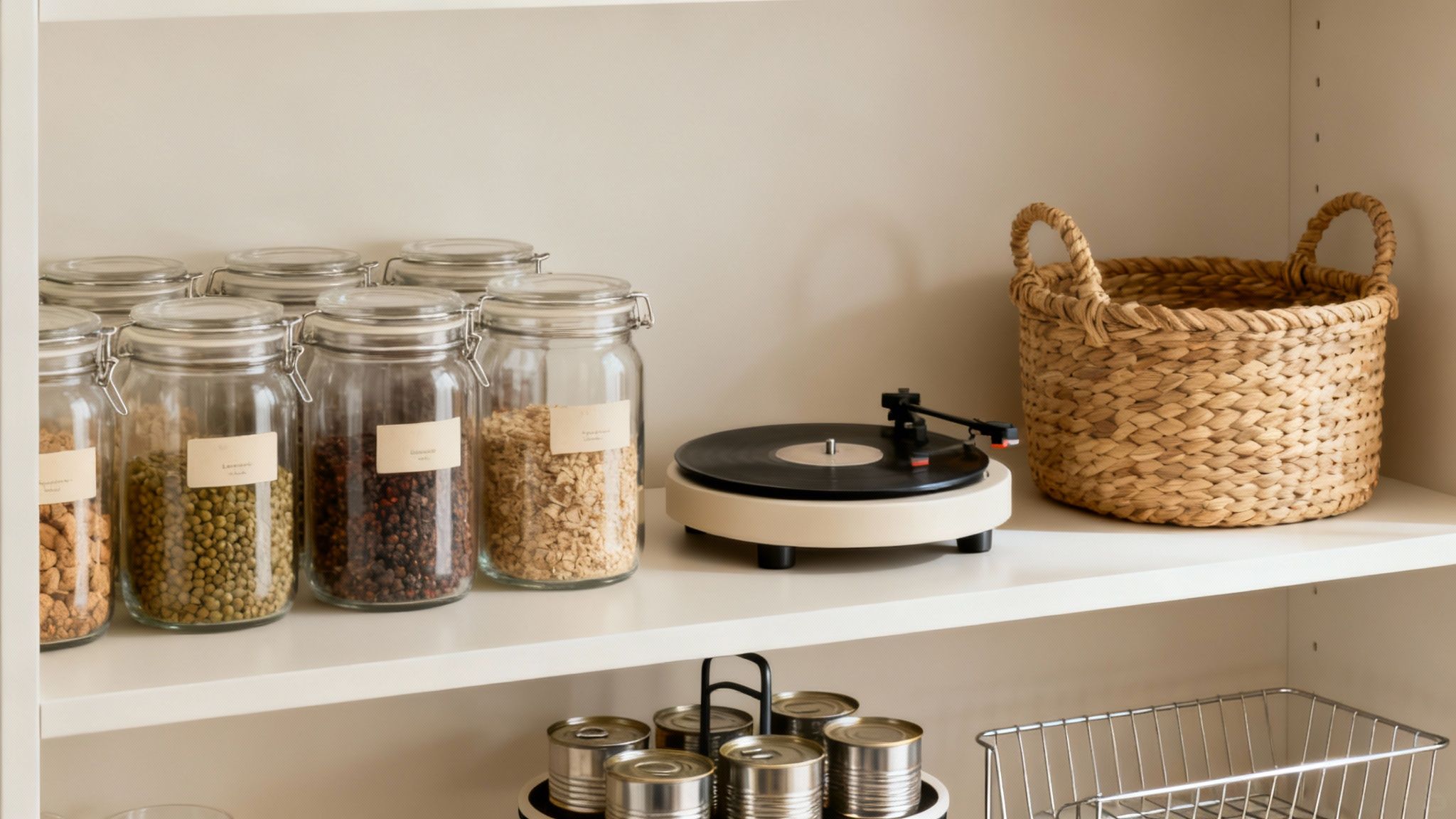If you want a pantry that actually stays organized, you have to be willing to make a bit of a mess first. The most crucial first step is a total reset—and that means pulling every single thing out.
Laying the Groundwork for a Functional Pantry

Alright, let's get into it. The first real move toward a perpetually organized pantry is embracing the temporary chaos. Take every single item off the shelves and spread it all out on your kitchen counter or dining table.
This is the only way to truly confront what you have hiding in there—from that lone can of water chestnuts to the three half-empty boxes of crackers your kids abandoned.
With the shelves completely bare, now is the perfect time for a deep clean. Wipe down every surface to get rid of dust, sticky spots, and old crumbs. Starting with a fresh, clean space feels like a mental reset and makes the final result so much more satisfying.
Get Brutal: Sort and Declutter
Now for the fun part. It’s time to be honest with yourself. Create three distinct piles: Keep, Toss, and Donate.
- Toss: Be ruthless. Immediately get rid of anything that's expired or has gone stale. Check the "best by" dates on your spices, canned goods, and baking supplies. You’ll probably be surprised by what you find.
- Donate: Set aside any non-perishable, unexpired food that your family just isn't going to eat. That specialty hot sauce you only tried once or the bag of lentils from a past recipe whim can go to a local food bank.
- Keep: This pile is for everything you actually use and love. As you add items to this group, start creating smaller, logical categories. Put all your baking supplies together, group pastas with grains, and line up all the canned vegetables. This initial grouping gives you a clear visual inventory of what you're working with.
This visual audit is the secret weapon for smarter organization and less food waste. It’s how you spot that you have four jars of paprika but no tomato sauce, which will directly influence your next grocery run.
This process does more than just clear clutter; it helps you understand your family’s real eating habits, which is a massive advantage when you’re learning how to plan weekly meals more effectively. You start to see the patterns in what you buy versus what you actually use.
It's no surprise that in North America, the demand for better systems is clear, with over 70% of households now using organizers to improve pantry function. This initial clear-out is the foundation—get this right, and all your other organizational efforts will actually stick.
Designing a Smarter Pantry with Strategic Zones
Now that your pantry is a clean slate, it’s time to rebuild it with a clear purpose. The secret to a pantry that actually stays organized is creating strategic zones. Think of it like a neighborhood map for your food, where everything has a logical home.
This method is all about grouping items based on how—and when—you use them. For example, you could create a "quick breakfast" bin with oats, coffee, and grab-and-go bars. Or, you might designate a corner for "baking supplies" so the flour, sugar, and vanilla are always together. This simple shift puts an end to that frantic mid-recipe search.
Think about your daily life. If you have kids, a low, easy-to-reach shelf with healthy snacks gives them the independence to grab their own. If pasta nights are a weekly ritual, it just makes sense to group noodles, jars of sauce, and canned tomatoes into a "weeknight dinners" zone.
Map Out Your Shelf Real Estate
Just creating the zones isn't enough; where you put them matters just as much. Your pantry’s vertical space is prime real estate, and how you use it can make or break the whole system.
The infographic below gives a great visual framework for shelf placement.

This visual gets right to the point: the items you use most often should be at eye level, while less-used backstock and heavy items get their own dedicated spots.
By placing your most-used items—like cooking oils, everyday spices, and snacks—between shoulder and waist height, you're making daily tasks smoother and more intuitive. It’s a small adjustment that has a huge impact on kitchen flow.
Higher shelves are perfect for duplicates, backstock, and things you only pull out on occasion. Down low, the floor or bottom shelves are ideal for those heavy, bulky items like cases of water, big bags of pet food, or potatoes.
If you're looking for more inspiration, check out these smart pantry organization ideas to help you visualize what's possible. When you organize your pantry this way, it stops being a messy closet and becomes a functional, dynamic part of your daily routine.
Selecting the Right Tools for Pantry Organization

Alright, you’ve mapped out your pantry zones—now for the fun part. Choosing the right containers and organizers is what really brings a system to life, turning those chaotic shelves into a space that’s both functional and beautiful. The goal here isn't just to buy a bunch of matching bins; it's about finding smart solutions that fit your space, budget, and daily routine.
One of the single most effective changes you can make is decanting items like cereal, rice, pasta, and snacks into clear, airtight containers. This isn't just for looks. It keeps food fresher for way longer and gives you an instant inventory check. No more digging through crushed boxes to see if you have enough crackers for the week—one quick glance and you know exactly what you have.
This simple habit is a big reason why jars and containers are staples in modern kitchens. In fact, they accounted for about 27% of the market share for kitchen storage back in 2023. It just goes to show how much people rely on them to create a practical, streamlined pantry.
Finding Your Perfect Container Match
There’s no one-size-fits-all answer for pantry storage. The best, most sustainable pantries I've seen almost always use a mix of materials, each chosen for a specific purpose.
- Clear Acrylic Bins: These are my go-to for corralling similar packaged goods, like granola bars, seasoning packets, or small bags of chips. You can see everything inside without even pulling the bin off the shelf.
- Glass Jars: Absolutely perfect for bulk goods like flour, sugar, lentils, and pasta. Glass is non-porous, so it won’t hold onto stains or odors, and it has a clean, timeless look.
- Woven Baskets: Baskets add a touch of warmth and are fantastic for hiding less sightly items. Think bags of potatoes or onions, extra paper towels, or even your stash of reusable shopping bags.
- Wire Organizers: A must-have for canned goods. Tiered risers let you see the cans hiding in the back, and simple under-shelf baskets are brilliant for creating usable space out of thin air.
Before you invest in a whole new set of containers, it's helpful to weigh the pros and cons of each type.
Pantry Container Comparison Guide
| Container Type | Best For | Pros | Cons |
|---|---|---|---|
| Glass | Flour, sugar, pasta, liquids | Airtight, non-porous, easy to clean, looks great | Can be heavy, breakable, often more expensive |
| Plastic/Acrylic | Snacks, cereal, crackers, boxed goods | Lightweight, durable, often stackable, budget-friendly | Can absorb odors/stains, may contain BPA |
| Woven Baskets | Potatoes, onions, bulky bags, linens | Aesthetically pleasing, good airflow, conceals clutter | Not airtight, harder to clean, items can fall through |
| Metal/Wire | Canned goods, jars, root vegetables | Durable, allows visibility, promotes airflow | Not for small loose items, can be bulky |
Ultimately, a combination of these options usually works best to create a pantry that’s both beautiful and hyper-functional.
Don't overlook the simple, hardworking tools. A turntable (or Lazy Susan) can make a deep corner cabinet genuinely useful, and an over-the-door rack adds an incredible amount of storage for spices and small jars.
If you have the space and are aiming for a fully integrated system, custom shelving can be a fantastic investment. The principles of creating tailored storage are universal, whether in a closet or a pantry. If you're looking to build a custom closet organizer, many of the same concepts—like maximizing vertical space and creating designated zones—apply directly to building your dream pantry.
Bringing Your New Pantry System to Life

Okay, you’ve done the hard part. The plan is made, the organizers are ready, and now it’s time for the most satisfying step: putting it all back together. This is where your vision for a flawlessly functional pantry really comes alive.
Start by decanting your dry goods—think pasta, rice, flour, and cereal—into those new airtight containers. This isn't just about looks; it makes everything easier to see, keeps ingredients fresh, and gets rid of bulky, half-empty packaging.
Once everything is out of its original box, the next step is absolutely non-negotiable for long-term success: labeling. A clear, consistent labeling system is what keeps the peace. It ensures everyone in the house can find what they need and, just as importantly, knows exactly where to put things back.
Putting Items in Their Place
Now, you can start loading everything back onto the shelves according to the zones you mapped out earlier. All your baking supplies go in the baking zone, your weeknight dinner staples go together, and the kids' snacks find their designated home. This intentional placement is what creates an intuitive system that doesn’t require a search party every time you need paprika.
As you start arranging, keep a couple of pro tips in mind to maximize your space and cut down on waste.
- Practice "First In, First Out" (FIFO): This is a simple trick restaurants use, and it works wonders at home. When you buy new canned goods or other items with expiration dates, place them at the back of the shelf. Slide the older items to the front. This little habit ensures you use things up before they expire.
- Create a Backstock Bin: Nothing is worse than buying a new jar of peanut butter only to find you already had two. Designate a specific container—usually on a high or low shelf—for your duplicates. When you finish the jar in your main "breakfast" zone, you’ll know exactly where to grab its replacement.
This phase is so much more than just restocking shelves; you're building a sustainable system from the ground up. Taking the time now to label everything and set up a backstock area are the small habits that prevent your pantry from descending back into chaos.
Following these steps for how to organize a kitchen pantry ensures your new setup isn't just beautiful—it's incredibly easy for the whole family to maintain.
Keeping Your Pantry Organized for Good
Let's be honest, the hard part isn't getting the pantry organized; it's keeping it that way. The secret to avoiding that slow slide back into chaos isn't a massive overhaul every month. It’s all about building small, sustainable habits that slot right into your weekly routine.
This doesn't need to be a huge time-suck. My favorite trick is what I call the 10-minute weekly reset. Before you head out for your big grocery run, just set a timer for ten minutes and do a quick tidy-up. Put that stray bag of chips back in its home, wipe down any sticky spots, and take a final look at your shopping list. This simple habit stops the clutter before it ever gets a chance to take over.
Sync Your Pantry with Your Shopping
An organized pantry is a game-changer when it’s linked directly to your shopping habits. I always keep a running grocery list somewhere impossible to ignore—a little whiteboard stuck to the inside of the pantry door works wonders, as does a shared note on your phone.
The second you use the last drop of olive oil, it goes on the list. No exceptions.
This single practice is a lifesaver. It stops you from buying duplicates you don't have room for and makes sure you always have what you need. It's also a surprisingly effective way to cut down on impulse buys and helps with smart food waste reduction strategies.
Getting the rest of the household on board is the final piece of the puzzle. Take a few minutes to walk everyone through the new system and explain why the labels are there. When everyone knows where things are supposed to go, keeping it tidy becomes a team effort.
This desire for a lasting system is exactly why over 60% of homeowners have recently invested in organization products. They’re not just looking for a quick fix; they want a system that works for the long haul. You can learn more about these pantry organization trends and what other people are doing.
Common Pantry Organization Questions Answered
Even the most organized person runs into little logistical hurdles when tackling a pantry makeover. Let's walk through some of the most common questions that pop up when you're in the thick of it, trying to create a system that actually sticks.
How Do I Organize a Small or Deep Pantry?
Ah, the dreaded small (or cavernously deep) pantry. These spaces are all about being clever with vertical real estate and making sure that can of pumpkin purée you bought last fall doesn't get lost in the abyss. The goal is to get everything in view without having to pull half the contents out.
Here’s how you can reclaim that tricky space:
- Go Vertical: I love using stackable clear bins. They let you use every single inch of height on a shelf while still letting you see exactly what’s inside at a glance. No more guessing games.
- Create Makeshift Drawers: For those super deep shelves, long and narrow baskets or dedicated pull-out drawer organizers are a lifesaver. You can just slide one out and grab what you need from the back, easy as that.
- Embrace the Turntable: A turntable, or Lazy Susan, is an absolute game-changer for awkward corners and deep shelves. A quick spin brings everything from the back right to the front.
- Don't Forget the Door: The back of the pantry door is prime, often-forgotten real estate. An over-the-door rack is perfect for spices, jars, and those little packets that always seem to disappear.
In a tight or deep pantry, the mission is simple: bring everything into your line of sight. If you can't see it, you won't use it. That's the fast track to food waste.
Should I Keep Food in Its Original Packaging?
This is one I get asked all the time, and honestly, the best approach is a hybrid one. It really comes down to the specific item and your daily routine. Decanting isn't for everything, but it's a fantastic solution for bulk items or anything that comes in flimsy, clutter-inducing packaging.
Think about your bulk dry goods—flour, sugar, rice, oats. The best way to store these is to transfer them into large, airtight containers. This does more than just look nice; it keeps them fresher for longer and protects them from pests. Just be sure to label each container with the contents and the date you bought it.
On the other hand, things like canned goods or individually wrapped snacks are perfectly fine in their original containers. To keep them from looking chaotic, just corral them. I use open-top bins or baskets to group similar items. You might have one bin for granola bars and another for small chip bags. It keeps them contained and easy for everyone to find.
And for any extra garden produce you want to save, check out these simple tips on how to freeze fresh zucchini and other veggies. It's a great way to reduce waste and enjoy summer flavors year-round. This strategy cuts down on clutter without adding a ton of extra work to your plate.
At Culinary Collective Atl, we know an organized kitchen is the foundation of a happy home. If you dream of incredible meals without the stress of planning and prep, discover our private chef services at https://www.theculinarycollectiveatl.com.





